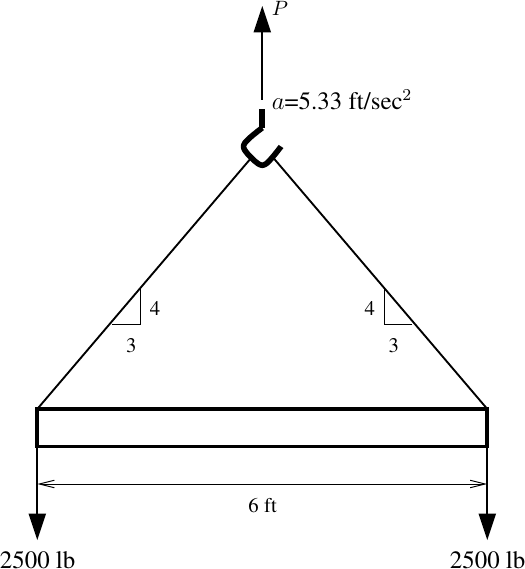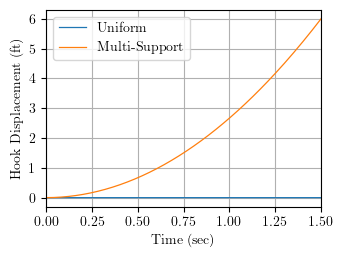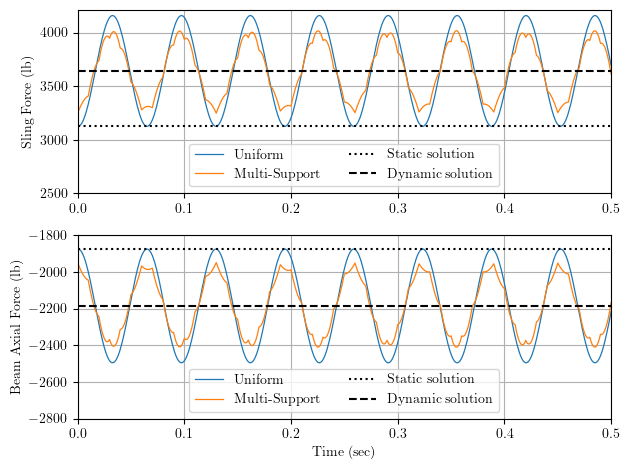OpenSees Cloud
OpenSees AMI
Spreader Beam Analysis
Original Post - 21 Feb 2024 - Michael H. Scott
Show your support at Buy Me a Coffee.
Problems involving beams are few and far between in Hibbeler 14th edition Engineering Mechanics: Dynamics. The problems mostly deal with springs, friction, pulleys, and things that rotate.
So, Problem 15-3 was a welcome sight.
A six foot long beam weighing 5000 lb is lifted from rest to a velocity of 8 ft/sec in 1.5 sec (constant acceleration of 5.33 ft/sec2). What is the tension force in the slings during the lift? Also, what is the compression force in the beam?
When the beam supports the load at rest, the static solution for the sling force is 3125 lb and 1875 lb compression force in the beam. While the hook is accelerating upward, the dynamic solution is 3642 lb for the sling force and 2185 lb for the beam compression.

Weighing 5000 lb, this beam is quite heavy for a 6 ft span, so the problem is likely a simplification of a spreader beam, which stabilizes a lifted load. This size spreader beam only weighs about 100 lb, leaving the additional 4900 lb as the weight of the lifted load.
Analyzing the spreader beam in OpenSees takes two truss elements and a beam. The hook is a pin support with rotation also fixed because the truss elements provide no rotational stiffness. There’s no need to split hairs between the beam self-weight and the lifted load, so I put half the total weight (2500 lb) at each end of the beam along with corresponding mass in only the vertical DOFs.
Then, for the lifting, think of the hook imposing vertical ground motion with constant acceleration. Although the effect of the hook motion can be simulated using a uniform excitation, you won’t get the hook velocity or displacement out of the analysis, which is likely not a big deal.
But if you do want to get the hook motion, you can impose the vertical acceleration as part of a multi-support excitation. However, the ground motion integrators in OpenSees cannot handle a constant (or linear) time series, so you have to use a path time series to define constant acceleration.
a = 5.33 # acceleration, a=8/1.5
if excitation == 'multi':
ops.timeSeries('Path',1,'-dt',10,'-values',a,a)
ops.pattern('MultipleSupport',1)
ops.groundMotion(1,'Plain','-accel',1)
ops.imposedMotion(0,2,1) # node, dof, gmTag
if excitation == 'uniform':
ops.timeSeries('Constant',1,'-factor',a)
ops.pattern('UniformExcitation',1,2,'-accel',1)
The computed vertical hook displacement is shown below for the uniform and multi-support excitations. As expected, the hook displacement is zero when using the uniform excitation.

The sling force and beam axial force response histories are shown below.

The forces obtained via uniform excitation are nice step function responses while the forces obtained via multi-support excitation involve other modes of dynamic response. The uniform excitation applies equivalent loads directly to the dynamic DOFs while some wave propagation is necessary in order to move the dynamic DOFs with the multi-support excitation. As such, the multi-support response is more sensitive to the axial stiffness of the slings than the uniform excitation.
At any rate, both responses oscillate about the rigid body dynamic solution. Also, there’s no damping in the OpenSees analysis–you can deal with damping at your leisure.
Mark Denavit provided input for this post.